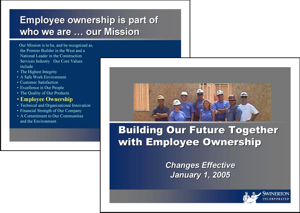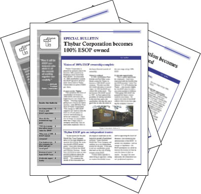Employees have a tendency to “tune in” and listen when you make a change in benefits. And the frequency or station tuned into most often is, WIII-FM — also known as “What is in it for me?” This is both a challenge and an opportunity. Both Swinerton Incorporated and Thybar Corporation recently made a change related to their retirement benefits and employee ownership. Workplace Development Inc. provided each company with customized assistance to develop a communication plan and tools to roll out the change.
Swinerton increased its company-paid match and started making the match in company stock in 2005. “We did a careful analysis and decided this was a good addition to retirement benefits, but we really did not know how employees would see it,” says Phyllis Smith, Chair of the Swinerton 401(k) and Savings Plan. Swinerton Incorporated, which employs over 1,800 people, offers construction services throughout the Western US. Employee ownership is highly valued at Swinerton, but expanding ownership as a part of retirement benefits had not been actively pursued in years. Swinerton is 100% employee owned; many employees earned Company stock as part of their compensation and a small piece of ownership in an Employee Stock Ownership Plan (ESOP) that was initiated nearly 20 years ago. With the assistance of Workplace Development, employees learned about the change in benefits and how the initiative fits with the company’s core values.
At Thybar Corporation, the company’s ESOP purchased remaining shares from stockholders in 2004. “Our ESOP has been buying stock in stages since 1993. But this was different because going 100% ESOP was the final realization of the long-term vision of the stockholders,” noted Bill Evitt, President of Thybar Corporation. Thybar Corporation, a manufacturer of custom sheet metal products for HVAC and sheet metal industries has facilities in Illinois, Ohio, Kentucky and Texas. When the transaction for purchasing the shares was finalized, leaders knew that it would be important to have information available to ESOP participants throughout the country. Thybar leaders wanted to anticipate and answer participant questions so that employee energy could focus on future opportunities for the business.
Even though these situations are very different, the questions that needed to be answered in developing effective communication are exactly the same.
What is important from an employee point of view?
When a change in benefits occurs, employees will have basic questions they will want answered early in the process. Early questions and concerns will revolve around understanding “What is in it for me?” While it is a simple question, getting clear answers to these questions requires forethought and planning. Shared ownership plans can be complex, and providing a detailed explanation may fail to answer the real questions.
Thybar leaders worked with Workplace Development to develop a “special bulletin” and presentation that dealt with the essential questions employees would want answered in a change to 100% ESOP ownership. For Swinerton, an executive presentation and basic brochures in both Spanish and English were tools that answered the fundamental questions people had about the change The four-page brochure allowed people in all parts of the company to talk about the change in their preferred language.
Are you ready for the tough questions?
After the simple questions have been answered, it’s time to get ready for the complicated questions. When you implement any change, a common reaction is to resist the change and at times challenge it. This can be true even when companies are providing a large enhancement to their benefits. Some employees will need more information before becoming comfortable with the change.
Leaders may get questions that sound suspicious such as “who’s really getting the benefit of this” or proclamations that “you don’t get something for nothing.” These types of reactions may appear ungrateful, but they are generally good indicators that people are putting their analytical skills to work in order to understand the change. Participants have not had the luxury of time to think about the change, so they will need to digest the information on their own terms.

Workplace Development provided presentation tools for executives of Swinerton Incorporated to communicate the change.
Workplace Development helped Swinerton create a Frequently Asked Question (FAQ) document and an online self-study guide. Both were uploaded to the company’s intranet. With answers to more than 40 questions relevant to the change, “people could view the FAQ’s to find answers to questions that they may not have asked in a presentation,” explains Phyllis Smith from Swinerton. Human Resources representatives received preliminary information on the resources allowing them to direct employees to the answers on this online resource.
Thybar Corporation President, Bill Evitt, involved key managers in a meeting to gain feedback on the presentation. The meeting provided managers with time to think about what employees may want to know, and it tested the assumptions about the questions that were important.
How will you enlist the right messengers?
Effective communication happens when there are multiple points of contact. But when a change is made to a benefit plan, usually only one or two people fully understand the change. The trick to successful communication is to create tools for multiple messengers to get involved in the communication process.
Thybar Corporation asked representatives of management to make a presentation to participants in each location. Managers received a presentation and handout that covered the key questions. These communication tools explained how the transaction was a win-win situation: for ESOP participants and for selling stockholders. Because some of the managers were also selling stockholders, they were primary messengers and were able to speak about their personal commitment to the long-term success of the company.
“It was really important that our executives communicated this initiative,” notes Smith from Swinerton when asked what made the difference in a successful effort. In a multi-state “Road Show,” executives delivered the presentation, reaffirmed the company’s commitment to employee ownership and answered questions. Executives took the opportunity to explain the change, encouraged diversified retirement savings in the 401(k) and deepened understanding of employee ownership. For the middle level leadership at Swinerton, it was essential to see top executives’ enthusiasm for the initiative. Overall enrollment in the retirement plan increased 5 % in early 2005, compared to the same time in 2004.
A change in benefits can present opportunities for employee retention, growing an ownership culture, and engaging employees in business improvement — but only if employees understand and appreciate the opportunity. Workplace Development’s communication plan, consulting and custom tools help companies “tune in” to the right frequency and connect to the big-picture advantages of the change.



